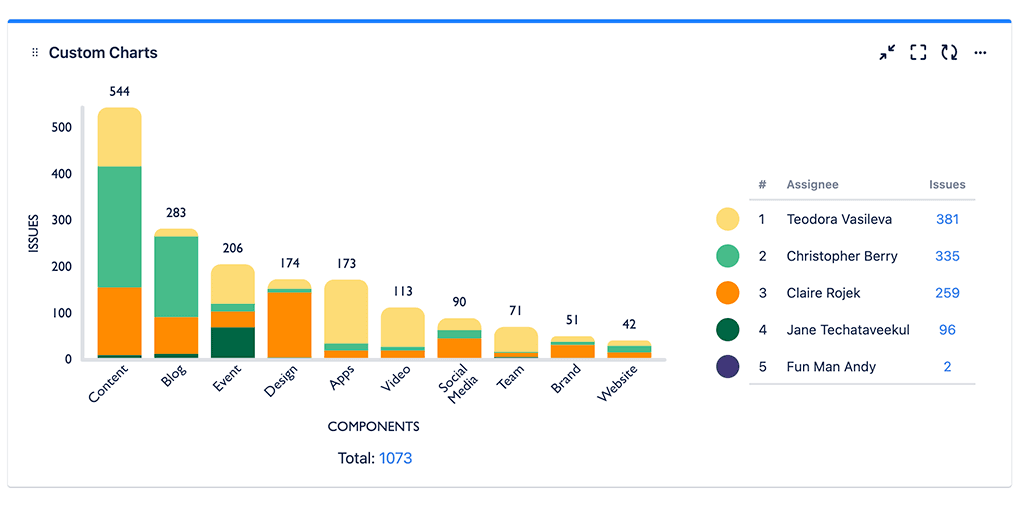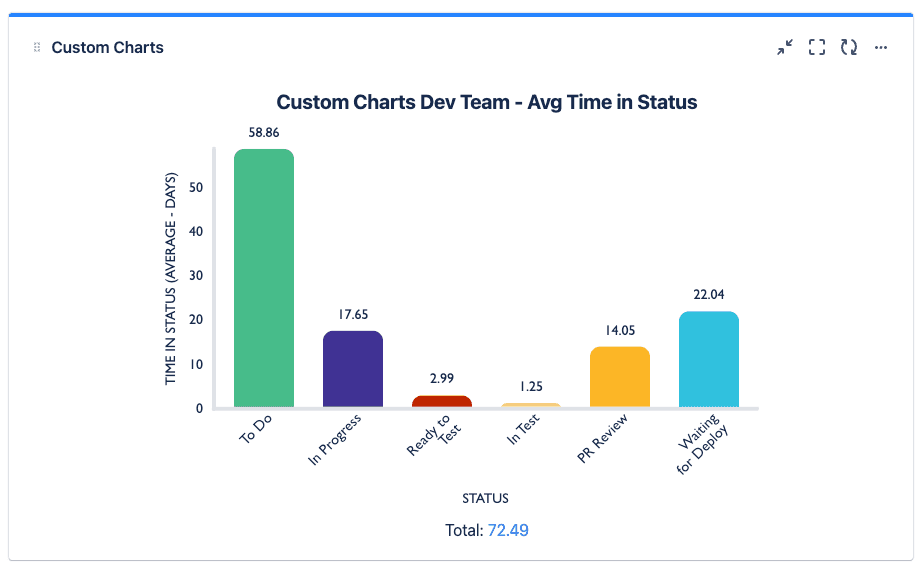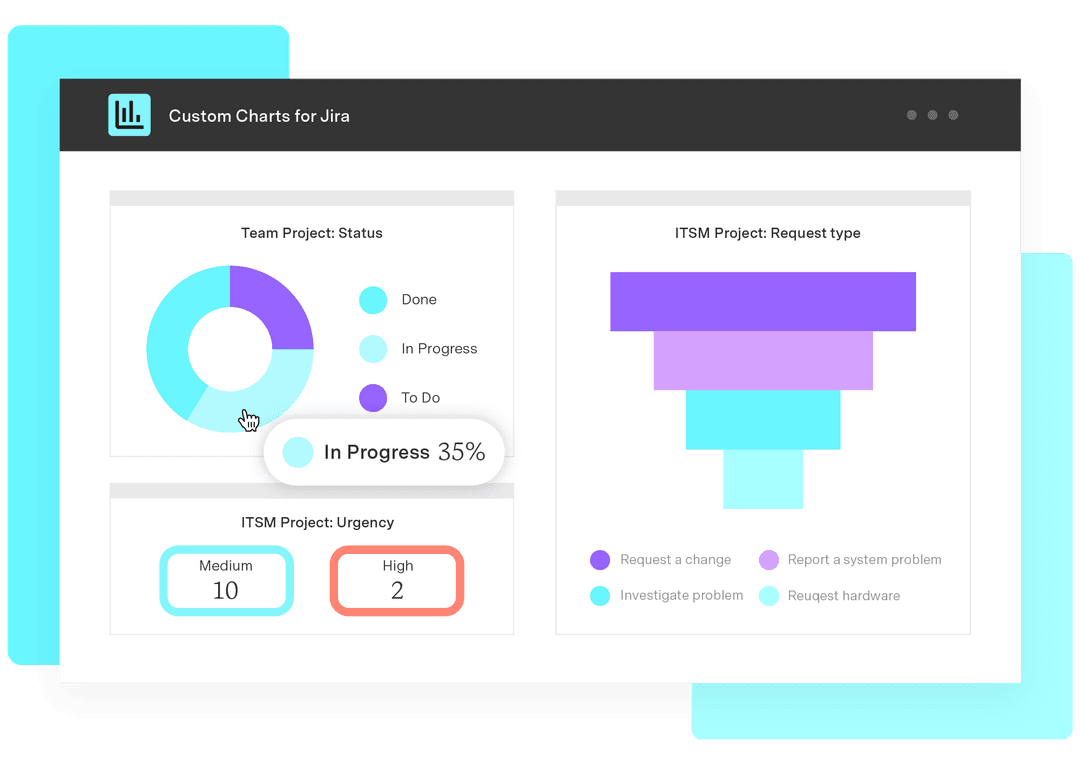App comparison: Built-In Jira Reports versus Custom Charts for Jira
Tempo Team
What are built-in reports for Jira?
Jira ships with 2 types of built-in reporting options: project reports and dashboard reports/gadgets. Many teams will use a combination of the out-of-the-box reporting options and marketplace apps to meet their reporting needs.
Built-in Jira reports: Strengths
Jira’s project reports and dashboard gadgets are extensive and span many different use cases, from burndowns for agile teams to time to resolution reports for service management teams to general reports that all kinds of teams can use.
Although the functionality is limited, the minimal configuration of reports means that they are relatively straightforward to set up.
Project reports are accessible from Scrum and Kanban boards and Jira Service Management projects directly, so teams can get to them easily from where they do their work.
Most project reports have gadget versions so that you can have the data on dashboards, which are better for ongoing monitoring.
There are certain reports available with out-of-the-box Jira that you can’t replicate with Atlassian Marketplace add-ons, so if even if you use a Marketplace add-on for better, more customizable reporting, you’ll still end up relying on native Jira for some insights.
Built-in Jira reports: Weaknesses
The reason Jira comes with so many preconfigured gadgets is because you can’t really make your own charts. There is, for example, no way to make your own bar chart—a popular chart type. The only bar charts available on native dashboards come as preconfigured gadgets showing set metrics such as time to resolution or average age of issues.
Reporting on data from 3rd party Jira apps using the built-in reports and gadgets is very limited. This prevents you from giving your audience a complete picture of what’s going on across your organization.
Cross-team and cross-project reporting is very limited in native Jira. Most of the gadgets, like burndowns and epic reports, only let you report on one project at a time, limiting company-wide visibility.
None of the reports are visually customizable and many look dated, limiting your ability to tell an engaging data story that drives your audience to action.
On Jira dashboards, there are few reports you can make from scratch, and only one of these is an actual chart (a pie chart), again limiting your ability to tell the right data story with the right visuals.
There is no way of filtering down the data in any of the native Jira gadgets or reports, which makes it difficult to focus your audience’s attention on a single variable without creating brand new charts every time.
Some reports are only available for Scrum teams or Kanban teams, even if they could be useful for teams not running agile by the book. This makes native Jira less suitable for business teams like marketing, HR, and the C-suite.
Even the custom reports come with very little customization. You can’t change colors, show/hide and combine data points, reposition the legend, or show percentages on the chart.
Your only option for charting in 2D with native Jira is a two-dimensional statistics table, and although tables can be useful, they’re not very visual.
You can’t report on time in status natively, which means you can’t see bottlenecks that may be causing your Jira issues to spend too long in certain statuses.
There are a number of powerful project reports, e.g. the Cumulative Flow Diagram and the Velocity Chart, that don’t have gadget versions and therefore cannot be replicated on the Jira dashboard.
You can’t make reports on your service-level agreement (SLA) metrics directly on a Jira dashboard; you have to make them on a per-project basis using Jira’s project reporting. You can then pull them onto the dashboard using the Service Project gadget, but if you wanted to change the configuration, you’d have to go back to the project. You’d also need to have one chart per project because the charts can’t span multiple projects. Therefore, IT service management (ITSM) teams lose the speed and efficiency that comes with dashboard reporting.
Native gadgets do not play well with team-managed projects, formerly known as next generation projects. This is because the specific fields and statuses found in those projects show up as duplicate entries in reports, making them difficult to use.
How Custom Charts for Jira wins
All the built-in charts in 1 gadget
The main gadget that comes with Custom Charts for Jira lets you make nearly all the reports from Jira’s library of dashboard gadgets. Several of the reports that are project-only natively can be remade in Custom Charts on a dashboard, so that you don’t need to do project reporting at all.
If you want preconfigured Jira charts, there are templates
The advantage of preconfigured charts is that you don’t need to try and guess how to display the metric you want to see. That’s why Custom Charts has chart templates, so that users get the benefit of a preconfigured head-start. However, you can tweak any template-based chart to your heart’s content, and add new templates as you wish.

Lots more chart types
Custom Charts comes with lots of chart types, including bar charts, tile charts, and funnel charts, allowing you to visualize your data in many different ways and create dashboards more likely to engage and inspire your audience.
Huge amounts of customizability
You have much more freedom to visualize your data how you want to with Custom Charts. You can customize colors, add descriptions, change chart type, change labels, hide/show data, combine segments, show percentages, show an issue total… the options are basically endless.
Chart in 2D
Sure, you can make a 2D table natively, but that’s a table. Custom Charts offers 2D stacked and grouped bar charts, along with 2D line graphs, for when you want something more visual to highlight your figures.

Highlight important points by filtering data down
Custom Charts comes with a separate gadget called Simple Search, which lets you filter down individual charts or entire dashboards to only show certain data. That way, all users can see the data that matters to them in a couple of clicks.
Custom Charts’ Issue List gadget is like Filter Results but better
Swap out the native Filter Results gadget for an Issue List, a separate gadget that comes with Custom Charts. Issue List is better than Filter Results in multiple ways. First, you can dynamically search with Simple Search. Second, you can choose from more than just Saved Filters to be the Source of your Issue List. Third, you can add Quick Filters and Smart Labels to draw attention quickly to particular Jira issues.
Report on time in status on Jira dashboards
Custom Charts comes with the ability to visualize time in status in many different ways and get an at-a-glance picture of time spent per epic, sprint, assignee, and more. This enables users to discover blockers, prioritize particular tasks/stories and epics, and see whether their estimates match their actual time spent.

Report on data from popular 3rd party apps
You can make all kinds of charts based on custom fields from Timesheets, Structure, ScriptRunner, Xray, Assets, Advanced Roadmaps, Jira Miscellaneous Custom Fields, and more. This is useful particularly for enterprises that have data spread across a lot of different tools.

Report on SLAs directly on Jira dashboards
ITSM teams can build charts out of their SLA data right there on the dashboard. You can also calculate the averages of your SLA figures and filter them by assignee, request type, and other custom fields without writing a single line of Jira Query Language, something you can’t do natively.
Overall, Custom Charts is basically as easy to use as the built-in reports, but offers users a lot more power and flexibility to visualize their data the way they want to.
Sign up for a demo
Register




































